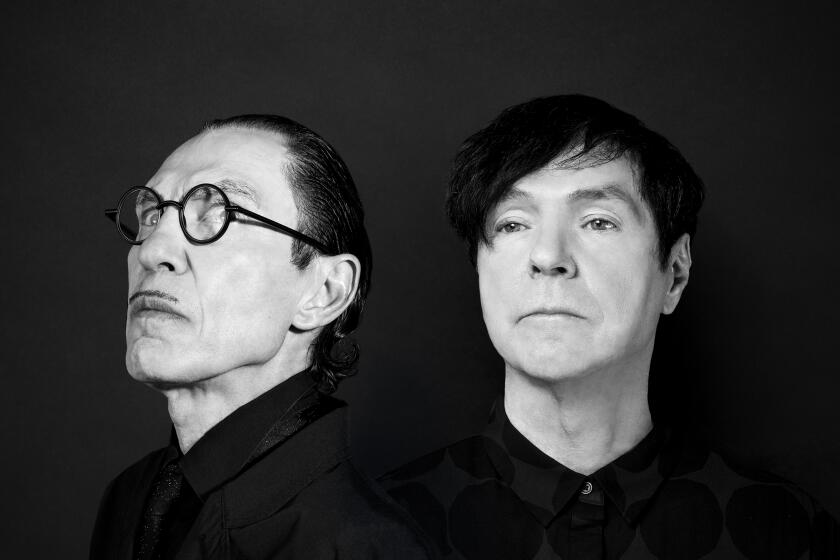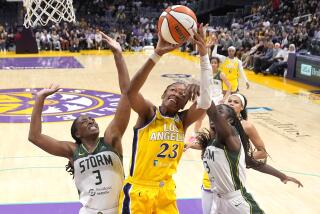Mael brothers riff on ‘The Sparks Brothers’ documentary and their favorite L.A. venue
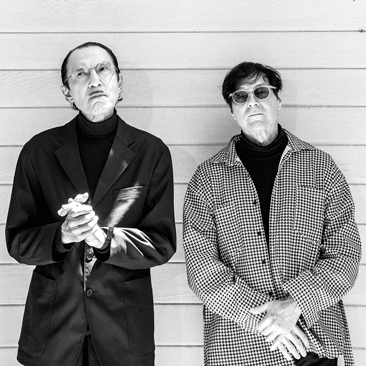
If you don’t know the band Sparks, you’re not alone. But the exhaustive, enormously entertaining new documentary “The Sparks Brothers,” directed by longtime fan Edgar Wright (“Shaun of the Dead,” “Baby Driver”), may go a long way to introducing this eclectic, wildly talented and influential musical group to less initiated viewers — and future devotees. It’s never too late.
Sparks, which consists of brothers Ron and Russell Mael, now 75 and 72, respectively, has been making music for more than 50 years, cranking out 25 inventive (or “creatively reckless,” as the film might have it) studio albums and nearly 500 songs that could be broadly considered “pop” but defy easy categorization. (They’re perhaps best known in the U.S. for the new wave-ish, MTV-era hit “Cool Places,” a duet with the Go-Go’s’ Jane Wiedlin.)
More identifiable artists, including Queen, Roxy Music and David Bowie, may come to mind on hearing such notable Sparks’ tunes as 1974’s “This Town Ain’t Big Enough for Both of Us” or 2017’s “Edith Piaf (Said It Better Than Me).” This might be why the Maels, who grew up in Pacific Palisades, have been dubbed the “best British group to ever come out of America.”
Still, despite living in London for a period in the 1970s, the brothers have considered L.A. home and share a wealth of local history that continues to this day.
The Times caught up with the Maels recently in a Zoom call that linked each of their Coldwater Canyon-area houses (Ron lives more “Westwood-y” than Russell). Despite their often inscrutable reputation, they were gracious, funny, thoughtful and open as they chatted about favorite local concert venues, the Beach Boys and shooting a 1970s disaster flick at Magic Mountain.
What does it feel like to have your 50-year music career compressed into one feature-length documentary? Is it weird?
Ron: It really is. We’ve resisted having a documentary made about us for so long because we felt that that kind of compression … would not be the kind of true look at what the band was — and is. But knowing what kind of filmmaker Edgar is, plus he stressed that he wanted to have each of our musical periods [represented] … If we were ever going to do it, he was the right person. We have no complaints.
Russell: We felt that Edgar’s film sensibility … his real kinetic kind of style and his love for music in his movies … was something that we thought he could bring to the Sparks story. When we set out to do this, we said, “Please, we hope this will be an Edgar Wright film, that it will look like an Edgar Wright film and that this won’t be the outlier — the dull, boring, dry documentary.”
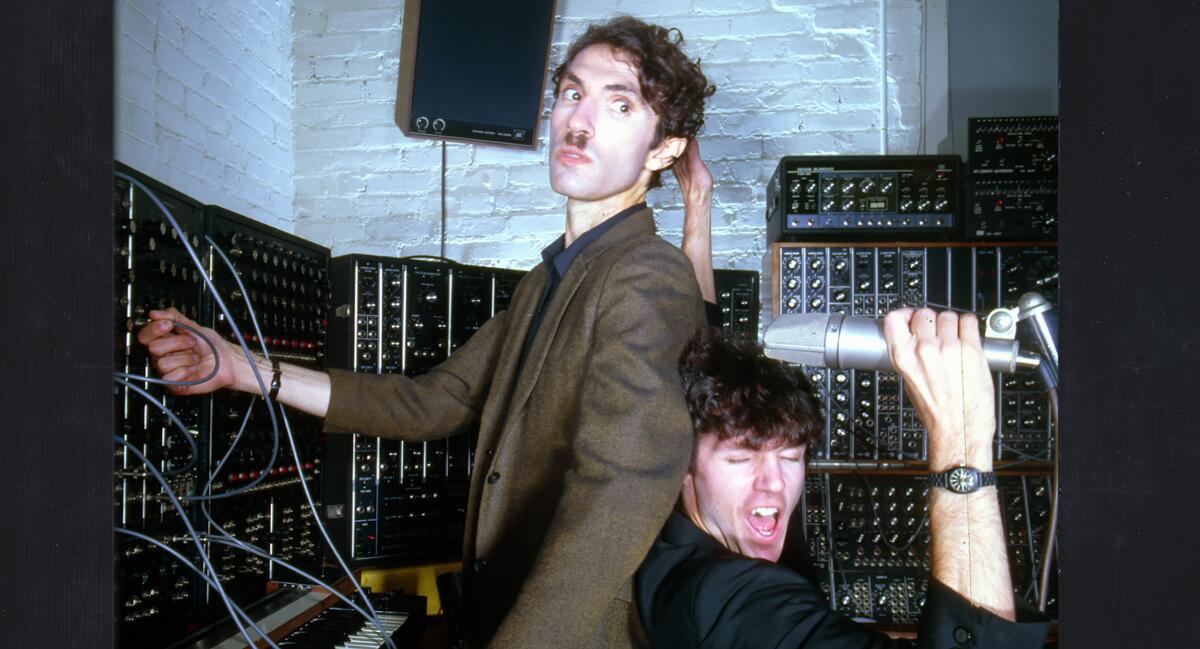
Los Angeles has been a major part of your lives, even though you’ve spent significant time abroad. How would you say growing up here, particularly in the 1960s, affected your music — or at least your creative impulses?
Ron: I know it’s not a physical thing about L.A., but the radio at that time — here were the three major stations: KHJ, KRLA and KFWB — played music that was just this amazing combination of things. [There was] Black music, white music, Bob Dylan’s “Like a Rolling Stone,” plus all these amazing on-air radio personalities like “Humble Harve” [Miller] and B. Mitchell Reed. It made pop music like this unbelievably colorful world, and that really was our musical education.
Russell: We lived at the beach for three months every year when we were going to school. That was our whole thing. From 9 in the morning till 7 at night, we’d be at the beach: Will Rogers Beach, Bel-Air [Bay Club] slightly up from Santa Monica … And then having bands like the Beach Boys, who you were listening to at the same time you were at the beach! They were singing about the beach, about the car culture … and going out on Friday night and going to high school football games. And that was all just part of our life in L.A.
Sparks ‘fanboy’ Edgar Wright pays loving tribute to 50-plus years of fun, focused musical ambition.
I love that as kids you saw the Beatles twice at the Hollywood Bowl. Yet you’ve never played the Bowl yourselves. Is that a dream of yours?
Russell: It would be amazing. We would really love to do that. Next week, we’re going to announce — and you can say it here — that we’re going to play Disney Hall in February. For us, it’s a more modern, iconic gig to play and something really prestigious.
You’ve played so many venues around L.A., places like the Greek Theatre, the Whisky a Go Go, the El Rey, the Palace, the Key Club. Any favorite experiences?
Ron: I think the Whisky would be the one for us, even though the attendance when we first were starting out was sparse, to put it generously. But for some reason, the owners of the place really liked the band and would have us back. It was a thrill to play there, because even at that time, it was a legendary place.
Also, we had seen our heroes playing there earlier: the Move … Tyrannosaurus Rex (before it was T-Rex) … the Beach Boys. So to know that you were playing in a venue where you had seen some of your heroes, it was pretty amazing.
Russell: We had played places that were really cool that are less on the map, like the Santa Monica Civic Auditorium. We played that in the ’70s, when we were still living in London. That was the place too where we had seen the T.A.M.I. Show [in 1964]. That was one of the best all-time concerts when we were in high school: The Rolling Stones, James Brown, the Beach Boys, the Supremes. So to get to play the Civic on our own, coming back from London on the success of the “Kimono My House” album, it was really special.
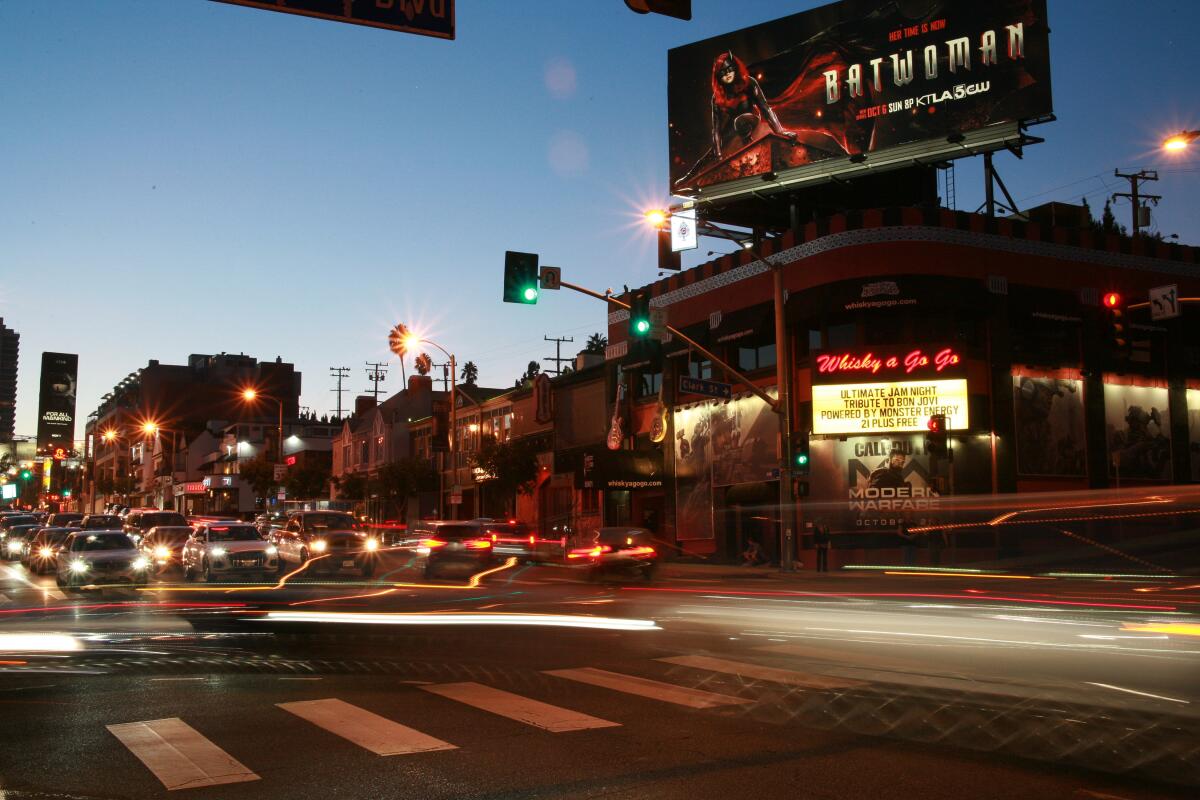
Was KROQ the first L.A. radio station to play your music? Did it start with the “Cool Places” single?
Russell: No. They were playing “Whomp That Sucker,” which predated that, and “Angst in My Pants” too. We really owe so much of what was happening with the band in the ’80s to them, because they treated Sparks’ music [not] like some kind of outsider music, but really part of their mainstream music.
Then, that resulted in [us] playing a lot of places around Los Angeles, like Magic Mountain, which had a KROQ event almost every Friday or Saturday; we would play those shows regularly. They were these amazing evenings that were really wild nights. They were fantastic.
Speaking of Magic Mountain, you appeared as the amusement park band in the 1977 film “Rollercoaster,” and that’s where your scenes were shot. What was it like working in a disaster movie?
Ron: I thought it was cool. They told us this movie was going to be bigger than “Jaws.” It’s kind of a strange thing looking back, because the movie is considered so cheesy in a way. But also, the other thing is that so many people first heard of Sparks from “Rollercoaster,” which was really weird to us. It was also strange because we were playing in front of people who were being paid to be excited.
Russell: We didn’t think it was the best movie ever made, but it had Henry Fonda and Richard Widmark and George Segal. So we always just joked that, “Yeah, it was our first movie, and we costarred with Henry Fonda.”
The song “Pacific Standard Time,” from your latest album, “A Steady Drip, Drip, Drip,” is a kind of atypical tribute to L.A. What were you trying to say with it?
Ron: The song is a commentary about loving the area, but with kind of a more nostalgic, darker tone. Not darker in a sinister way but more of a melancholy feel. The thought of “melancholy” and “Los Angeles” are not usually linked together, but there is that — at least for us. So much of the time, Los Angeles is reflected in “blue skies and sunshine,” and in this song, the fog is moving in. And that’s a part of life as well.
More to Read
Only good movies
Get the Indie Focus newsletter, Mark Olsen's weekly guide to the world of cinema.
You may occasionally receive promotional content from the Los Angeles Times.
